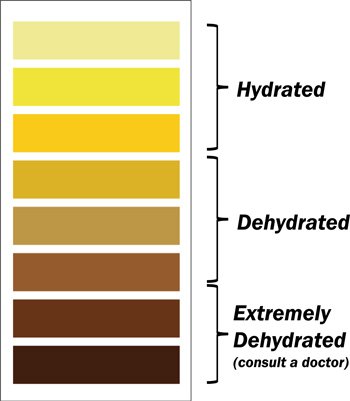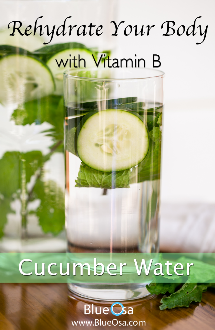Did You Know?
The amount of water in the human body changes as you age. From the very beginning of our lives and up until year one, our bodies are made up of roughly 75 to 78 percent water. After that first year it drops significantly to around 65%. Finally, as we move into our adulthood the percentage can drop between 50 to 60 percent depending on a person’s age, gender and fat content. Fat content affects our body’s water percentage due to the fact that fatty tissue has less water than lean tissue. This results in women, who naturally have more fatty tissue, and people who are overweight having lower water percentages.
Now you know roughly how much of your body is made up of that high quality H20, but do you know why?

If you are lucky enough to live in a country where drinking water is readily available, consuming it is ingrained in your routine. The amount we drink however varies considering the numerous other options the population has to choose from. What you may not know is that not only do our bodies need water to quench our thirst,it is also vital for our organs, digestion and temperature regulation according to the U.S. Geological Survey.
How Water Helps Your Body Survive Day to Day:
- Forms saliva, which helps with digestion
- Keeps mucous membranes moist
- Allows body’s cells to grow, reproduce and survive
- Flushes body waste
- Lubricates joints
- Needed for proper brain function
- Regulates body temperature
- Acts as a cushion for brain and spinal cord
- Helps send oxygen all over the body
Dehydration Nation
Our bodies and water go hand in hand but unfortunately we don’t always know right away when we need to increase our intake. Studies show that by time humans notice they are thirsty we have already lost two to three percent of our water; dehydration has already set in at a one percent loss.
The fact is, we are constantly losing water through various ways. The majority of people think of sweating as the primary reason that they are dehydrated. In reality there are a handful of ways water escapes. The most common is through our urine; this is also the best way to see just how dehydrated your body is (see chart below).
Less obvious ways include insensible losses, which refers to the loss of water through our skin, respiration and feces.

Effects of Dehydration
Although most people walk around daily in a state of dehydration without even knowing it, the short-term and long-term effects of depriving your body of the proper amount of water can have mild to serious consequences.
Some of the beginning signs that you are already dehydrated include dry mouth, fatigue and dull aching headaches. If you notice any of these symptoms, they can usually be alleviated by filling up your cup and downing a few glasses of water.
Once your water percentage has dropped by two or more percent you may begin experiencing more intense symptoms such as muscle cramps and spasms, vomiting, dizziness, increase or decrease in blood pressure and even constipation. At this point the person would want to begin slowly drinking water, juice and/or sports drinks over the course of two to four hours and get plenty of rest.
Finally, when extreme dehydration sets in a person may experience heat stroke. This is considered a medical emergency as it can adversely affect the brain and other internal organs. If you suspect someone is experiencing heat stroke, call 9-1-1 or seek medical attention immediately.
Not all long-term dehydration symptoms are as extreme as heat stroke right away, but will evolve and become noticeable with time. For example some people notice that their skin ages more quickly as it dries out and tightens. Others can develop conditions such as stomach ulcers, due to the thinning of the stomach lining, and high cholesterol, as a way to cope with the loss of liquids from their cells.
Some of the beginning signs that you are already dehydrated include dry mouth, fatigue and dull aching headaches. If you notice any of these symptoms, they can usually be alleviated by filling up your cup and downing a few glasses of water.
Once your water percentage has dropped by two or more percent you may begin experiencing more intense symptoms such as muscle cramps and spasms, vomiting, dizziness, increase or decrease in blood pressure and even constipation. At this point the person would want to begin slowly drinking water, juice and/or sports drinks over the course of two to four hours and get plenty of rest.
Finally, when extreme dehydration sets in a person may experience heat stroke. This is considered a medical emergency as it can adversely affect the brain and other internal organs. If you suspect someone is experiencing heat stroke, call 9-1-1 or seek medical attention immediately.
Not all long-term dehydration symptoms are as extreme as heat stroke right away, but will evolve and become noticeable with time. For example some people notice that their skin ages more quickly as it dries out and tightens. Others can develop conditions such as stomach ulcers, due to the thinning of the stomach lining, and high cholesterol, as a way to cope with the loss of liquids from their cells.
Blue Osa: Ahead of the Curve
Here at Blue Osa we understand how important water is to our guests overall health especially considering the humidity here in the Osa Peninsula hovers around 75% during our dry season and escalates to 90% during July, October and December according to CostaRica.com. Other places with high humidity throughout the year include South and Southeast Asia, Kuala Lumpur and Singapore.
A high level of humidity means that there is a lot of moisture in the air which doesn’t trigger our bodies to start sweating even though the heat can feel oppressive at times. As our visitors are usually engaging in physical activities such as hiking, swimming, yoga, horseback riding and personal training, this requires them to increase their water take even more.
Vitamin Water
In order to encourage the proper water consumption we provide our guests with free vitamin water all day long and a cup with their name on it to eliminate waste. Each type of water provides different restorative properties to the body. The table below describes each vitamin water we offer, benefits and calories of each type of beverage.

| Water Type | Benefit | Vitamins and Minerals | Calories (Based on Using Whole Fruit) |
| Cucumber | Rehydration | A, C, K, Iron, Calcium and Potassium | <50 |
| Watermelon | Increases Our Cardiovascular Health | A, C, B1, B6, Magnesium and Potassium | <50 |
| Star fruit | Improved heart rate & Blood Pressure | C and B-complex including B6 | <30 |
| Pineapple | Reduces muscle soreness | Thiamin, Riboflavin, B6, Magnesium, Manganese and Potassium | <50 |
| Cucumber Orange | Helps fight | C, B1, A, Calcium, Copper and Potassium | <100 |
Drinking the adequate amount of water throughout the day doesn’t have to be a chore. Incorporating fruits such as the cucumber, pineapple, orange, watermelon and star fruit not only help you achieve the proper water intake but allow you to enjoy the flavors of your favorite fruits without artificial flavorings or additional calories.

Want to remember the vitamin water benefits? Head over to the Blue Osa Pinterest and pin these yummy and nutritious drinks to your personal health and wellness boards!

About the Author
 Sarah Barnes is a level 200 Registered Yoga Teacher, photographer, writer/blogger, communications professional and owner of Modern Warrior Yoga . Sarah is an alumni of Texas Tech University where she graduated with International Business and a PhotoCommunications degrees. She recently left her job as the lead spokesperson for Sherwin Alumina Company to explore the world and is currently volunteering at Blue Osa as a blogger, photographer and yoga instructor.
Sarah Barnes is a level 200 Registered Yoga Teacher, photographer, writer/blogger, communications professional and owner of Modern Warrior Yoga . Sarah is an alumni of Texas Tech University where she graduated with International Business and a PhotoCommunications degrees. She recently left her job as the lead spokesperson for Sherwin Alumina Company to explore the world and is currently volunteering at Blue Osa as a blogger, photographer and yoga instructor.
Follow her journey and adventures in Costa Rica in her blog.






